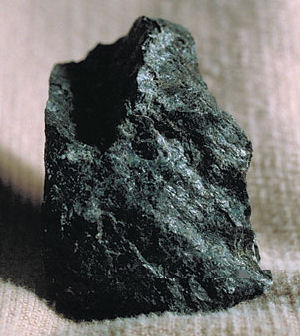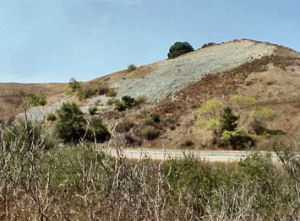California State Rock
| Serpentine |
|
Adopted:April 20, 1965 |
 |
| Serpentine: California State Rock |
Adoption of the California State Rock
Senator Luther E. Gibson, of Solano County, had served in the California State Senate since 1948.
On January 27, 1965, he introduced Senate Bill No. 265 (SB 265) in the Senate designating native gold as California's official state mineral and serpentine as California's official state rock.
Serpentine was described as a spotted, mottled mostly dull green rock resembling a serpent's skin. It was found in California but was not unique to the state.
The green serpentine was considered an attractive rock, suitable for ornamental stone-work. Polishing could produce a marble-like sheen.
Often referred to as verde antique or serpentine marble, it was used to craft small items such as bookends and paper weights and also used for decorative elements on buildings throughout the state.
Serpentine also served, and serves, as a host rock for minerals such as chromite, magesite, cinnabar, and chrysotile asbestos.
In an April 14, 1965 letter to Governor Edmond G. Brown, urging the Governor's approval of Senate Bill No. 265, DeWitt Nelson, and Director of the California Department of Conservation wrote:
"Although serpentine is not unique to California, it is by no means widely distributed elsewhere; and in many states does not exist at all. Serpentine indirectly is of great economic importance to California. It is a host rock for the state's newest and most rapidly--growing mineral industry--asbestos, now bringing in several millions of dollars annually. It is an attractive rock, selected varieties of serpentine make good cutting material and is used for bookends, paper weights, etc. Designating serpentine as the state rock will increase the market for such items and improve the local economy in a number of places."
Mr. Nelson also expressed his enthusiam for being the first state to adopt a state mineral and a state rock.
"At the moment, California has the opportunity of being the first state to recognize this need and of making a selection in advance of any other states."
 |
| Serpentine exposed on hillside |
The legislation had the support of the California Federation of Mineralogical Societies, and the ideas for a state mineral and a state rock were endorsed by the California Academy of Sciences and the California Division of Mines and Geology.
SB 265 was approved by a full vote of the California Senate on March 22, 1965 and sent on to the Assembly for their consideration.
Assemblyman Pearce Young of Napa County sponsored the bill in the Assembly. A little more than two weeks after its approval in the Senate, on April 8, 1965, SB 265 was approved unanimously (69-0) by the Assembly
On April 20, 1965, Governor Edmond G. Brown signed Senate Bill No. 265 designating native gold as California's official state mineral and serpentine as California's official state rock.
CHAPTER 89
An act to add Sections 425.1 and 425.2 to the Government Code, relating to state emblems.
[Approved by Governor April 20, 1965. Filed with Secretary of State April 20, 1965.]
The people of the State of California do enact as follows:
SECTION 1. Section 425.1 is added to the Government Code to read:
425.1. Native gold is the official State Mineral and mineralogic emblem.
SEC. 2. Section 425.2 is added to the Government Code to read:
425.2. Serpentine is the official State Rock and lithologic emblem.
California was the first state to adopt an official state mineral and an official state rock.
Chrysotile asbestos, occurring in serpentine, is a carcinogen listed by the EPA. Because of serpentine's association with asbestos and the demonstrated health hazards of asbestos, there have been calls for stripping the serpentine of its title of official state rock.
California Law
The following information was excerpted from the California Government Code, Title 1, Division 2, Chapter 2.
CALIFORNIA GOVERNMENT CODE
TITLE 1. GENERAL
DIVISION 2. STATE SEAL, FLAG, AND EMBLEMS
CHAPTER 2. STATE FLAG AND EMBLEMS
SECTION 420-429.8
425.2. Serpentine is the official State Rock and lithologic emblem.
Source: California State Legislature, California Law, April 3, 2008.
Source: California State Legislature: Assembly Chief Clerk, Session Archives, March 27, 2008.
Source: Letter from Department of Conservation Director DeWitt Nelson to Governor Edmond G. Brown, April 14, 1965.
Source: State Names, Seals, Flags and Symbols: A Historical Guide Third Edition, Revised and Expanded by Benjamin F. Shearer and Barbara S. Shearer. Greenwood Press; 3 Sub edition (October 30, 2001).
Additional Information
California State Rock:
Serpentine, California State Rock, Note 14 from the California Geological Survey.
McLaughlin Reserve Protects California's State Rock:
The University of California's Donald and Sylvia McLaughlin Reserve, located at the junction of Napa, Yolo, and Lake Counties in the North Coast Ranges, an area rich in serpentine specialist plants, or endemics.
Serpentinite:
On the roof garden of the Oakland Museum of California.
Geologists protest bill to remove state rock:
Senator, scientists argue over asbestos in serpentine
CaliforniaJade.com:
Online Letter to the Governor: A site dedicated to promoting California Jade as California's state stone.
California Serpentines: Flora, Vegetation, Geology, Soils, and Management Problems,
by Arthur R. Kruckeberg, 180 pages, University of California Press (April 12, 1985) This is the first comprehensive treatment of an important segment of the flora of California: native plants that have varying degrees of fidelity to serpentine rock and soil that make up over 1100 square miles in the Coast Ranges and the Sierra Nevada.
Introduction to California Soils and Plants: Serpentine, Vernal Pools, and Other Geobotanical Wonders,
by Arthur R. Kruckeberg, 296 pages, University of California Press; 1 edition (September 17, 2006) Carnivorous pitcher plants, pygmy conifers, and the Tiburon jewel flower, restricted to a small patch of serpentine soil on Tiburon Peninsula in Marin County, are just a few of California's many amazing endemic plants--species that are unique to particular locales.
Serpentine Geoecology of Western North America:
National Biological Information Infrastructure: About the book, Serpentine Geoecology of Western North America: Geology, Soils, and Vegetation.
Serpentine Geoecology of Western North America: Geology, Soils, and Vegetation,
by Earl B. Alexander, Robert G. Coleman, Todd Keeler-Wolfe, and Susan P. Harrison, 528 pages, Oxford University Press, USA (November 2, 2006) Geoecology is a fruitful interdisciplinary field, relating rocks to soils to plant and animal communities and studying the interactions between them. Modern geoecology especially concentrates on showing how geology and soils affect the structure, composition, and distribution of plant
communities in a certain research area. This book applies the principles of geoecology to Western North America, and to a specific kind of rock, the fascinating serpentine belts that run along the continental margins of the West Coast from Alaska to Baja.
|




